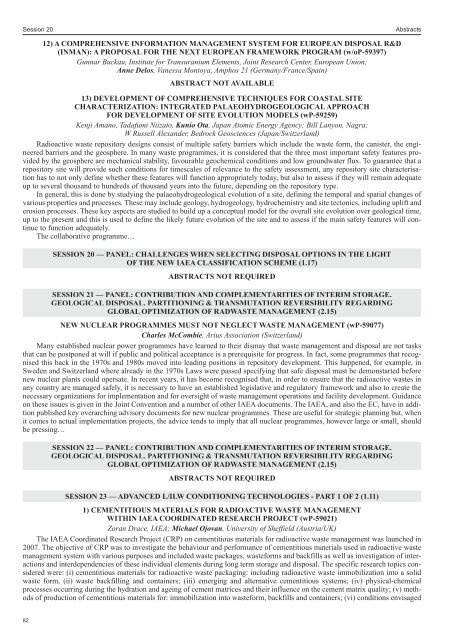ICEM11 Final Program 9.7.11pm_ICEM07 Final Program ... - Events
ICEM11 Final Program 9.7.11pm_ICEM07 Final Program ... - Events
ICEM11 Final Program 9.7.11pm_ICEM07 Final Program ... - Events
Create successful ePaper yourself
Turn your PDF publications into a flip-book with our unique Google optimized e-Paper software.
Session 20 Abstracts<br />
12) A COMPREHENSIVE INFORMATION MANAGEMENT SYSTEM FOR EUROPEAN DISPOSAL R&D<br />
(INMAN): A PROPOSAL FOR THE NEXT EUROPEAN FRAMEWORK PROGRAM (w/oP-59397)<br />
Gunnar Buckau, Institute for Transuranium Elements, Joint Research Center, European Union;<br />
Anne Delos, Vanessa Montoya, Amphos 21 (Germany/France/Spain)<br />
ABSTRACT NOT AVAILABLE<br />
13) DEVELOPMENT OF COMPREHENSIVE TECHNIQUES FOR COASTAL SITE<br />
CHARACTERIZATION: INTEGRATED PALAEOHYDROGEOLOGICAL APPROACH<br />
FOR DEVELOPMENT OF SITE EVOLUTION MODELS (wP-59259)<br />
Kenji Amano, Tadafumi Niizato, Kunio Ota, Japan Atomic Energy Agency; Bill Lanyon, Nagra;<br />
W Russell Alexander, Bedrock Geosciences (Japan/Switzerland)<br />
Radioactive waste repository designs consist of multiple safety barriers which include the waste form, the canister, the engineered<br />
barriers and the geosphere. In many waste programmes, it is considered that the three most important safety features provided<br />
by the geosphere are mechanical stability, favourable geochemical conditions and low groundwater flux. To guarantee that a<br />
repository site will provide such conditions for timescales of relevance to the safety assessment, any repository site characterisation<br />
has to not only define whether these features will function appropriately today, but also to assess if they will remain adequate<br />
up to several thousand to hundreds of thousand years into the future, depending on the repository type.<br />
In general, this is done by studying the palaeohydrogeological evolution of a site, defining the temporal and spatial changes of<br />
various properties and processes. These may include geology, hydrogeology, hydrochemistry and site tectonics, including uplift and<br />
erosion processes. These key aspects are studied to build up a conceptual model for the overall site evolution over geological time,<br />
up to the present and this is used to define the likely future evolution of the site and to assess if the main safety features will continue<br />
to function adequately.<br />
The collaborative programme…<br />
SESSION 20 — PANEL: CHALLENGES WHEN SELECTING DISPOSAL OPTIONS IN THE LIGHT<br />
OF THE NEW IAEA CLASSIFICATION SCHEME (1.17)<br />
ABSTRACTS NOT REQUIRED<br />
SESSION 21 — PANEL: CONTRIBUTION AND COMPLEMENTARITIES OF INTERIM STORAGE,<br />
GEOLOGICAL DISPOSAL, PARTITIONING & TRANSMUTATION REVERSIBILITY REGARDING<br />
GLOBAL OPTIMIZATION OF RADWASTE MANAGEMENT (2.15)<br />
NEW NUCLEAR PROGRAMMES MUST NOT NEGLECT WASTE MANAGEMENT (wP-59077)<br />
Charles McCombie, Arius Association (Switzerland)<br />
Many established nuclear power programmes have learned to their dismay that waste management and disposal are not tasks<br />
that can be postponed at will if public and political acceptance is a prerequisite for progress. In fact, some programmes that recognised<br />
this back in the 1970s and 1980s moved into leading positions in repository development. This happened, for example, in<br />
Sweden and Switzerland where already in the 1970s Laws were passed specifying that safe disposal must be demonstarted before<br />
new nuclear plants could opersate. In recent years, it has become recognised that, in order to ensure that the radioactive wastes in<br />
any country are managed safely, it is necessary to have an established legislative and regulatory framework and also to create the<br />
necessary organizations for implementation and for oversight of waste management operations and facility development. Guidance<br />
on these issues is given in the Joint Convention and a number of other IAEA documents. The IAEA, and also the EC, have in addition<br />
published key overarching advisory documents for new nuclear programmes. These are useful for strategic planning but, when<br />
it comes to actual implementation projects, the advice tends to imply that all nuclear programmes, however large or small, should<br />
be pressing…<br />
SESSION 22 — PANEL: CONTRIBUTION AND COMPLEMENTARITIES OF INTERIM STORAGE,<br />
GEOLOGICAL DISPOSAL, PARTITIONING & TRANSMUTATION REVERSIBILITY REGARDING<br />
GLOBAL OPTIMIZATION OF RADWASTE MANAGEMENT (2.15)<br />
ABSTRACTS NOT REQUIRED<br />
SESSION 23 — ADVANCED L/ILW CONDITIONING TECHNOLOGIES - PART 1 OF 2 (1.11)<br />
1) CEMENTITIOUS MATERIALS FOR RADIOACTIVE WASTE MANAGEMENT<br />
WITHIN IAEA COORDINATED RESEARCH PROJECT (wP-59021)<br />
Zoran Drace, IAEA; Michael Ojovan, University of Sheffield (Austria/UK)<br />
The IAEA Coordinated Research Project (CRP) on cementitious materials for radioactive waste management was launched in<br />
2007. The objective of CRP was to investigate the behaviour and performance of cementitious materials used in radioactive waste<br />
management system with various purposes and included waste packages, wasteforms and backfills as well as investigation of interactions<br />
and interdependencies of these individual elements during long term storage and disposal. The specific research topics considered<br />
were: (i) cementitious materials for radioactive waste packaging: including radioactive waste immobilization into a solid<br />
waste form, (ii) waste backfilling and containers; (iii) emerging and alternative cementitious systems; (iv) physical-chemical<br />
processes occurring during the hydration and ageing of cement matrices and their influence on the cement matrix quality; (v) methods<br />
of production of cementitious materials for: immobilization into wasteform, backfills and containers; (vi) conditions envisaged<br />
82
















